Enoch Rhodes Dayley
19 September 1837 – 13 November 1892
James and Isabelle Dayley spent the early years of their married
lives traveling in company with her parents, the Thomas McBride
family, during the persecutions of the Church of Jesus Christ of
Latter Day Saints in Missouri and Illinois. In August of 1833, they
started out for Jackson County, Missouri to join the church members
there. It being so late in the season, they were unable to go further
than Richland County, Ohio. It was there that James and Isabelle were
married on March 18, 1834. They stayed until the spring of 1834, then
moved on to Bowling Green, Pike County, where they resided for about
two years. It was here the first child, Elizabeth, was born and died.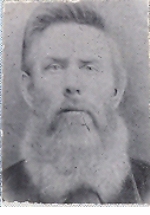
In the spring of 1836, they moved to Ray County, Ohio and joined a branch of the church. They stayed about three months, during which time they suffered a great deal with ague fever. The howling of the mob was heard on every side, so they decided to move on to Caldwell County, Missouri on Grand River about three-quarters of a mile from Haun's Mill on Shoal Creek. They made their home there and on the September 19, 1837, Enoch Rhodes, their first son was born. He was the second child in a family of eleven children. Enoch was named after his mother's late husband, who was also his father's half brother.
A branch of the Church was organized at Haun's Mill, presided over by David Evans. Though many of the followers of the Prophet Joseph Smith had been beaten, tarred and feathered, and driven from their homes, persecutions continued. Threats were strong against the Mormons. A small few, realizing the dangerous situation in which they were placed, decided to adopt measures to defend themselves against the raids of the mob they knew were coming. They placed a guard at the Mill. On the afternoon of Tuesday, October 30, 1838, a mob under the leadership of Colonel William O. Jennings attacked a little settlement of Saints at Haun's Mill. Thirteen people were killed, including Enoch's grandfather, Thomas McBride. Others were severely wounded but recovered.
When
the mob struck, Isabelle took her baby Enoch, who was almost one year
old, and hid in the willows along the stream for safety. After the
massacre, they were ordered to leave the state of Missouri.
Therefore, it was necessary to dispose of their home and land at the
Mill. Their property was worth about one thousand dollars, but in
February 1839, they were forced to sell it for a wagon worth about
forty dollars, a mare valued at forty dollars and an old horse worth
about twenty dollars. In all, they received less than one hundred
dollars for the whole farm.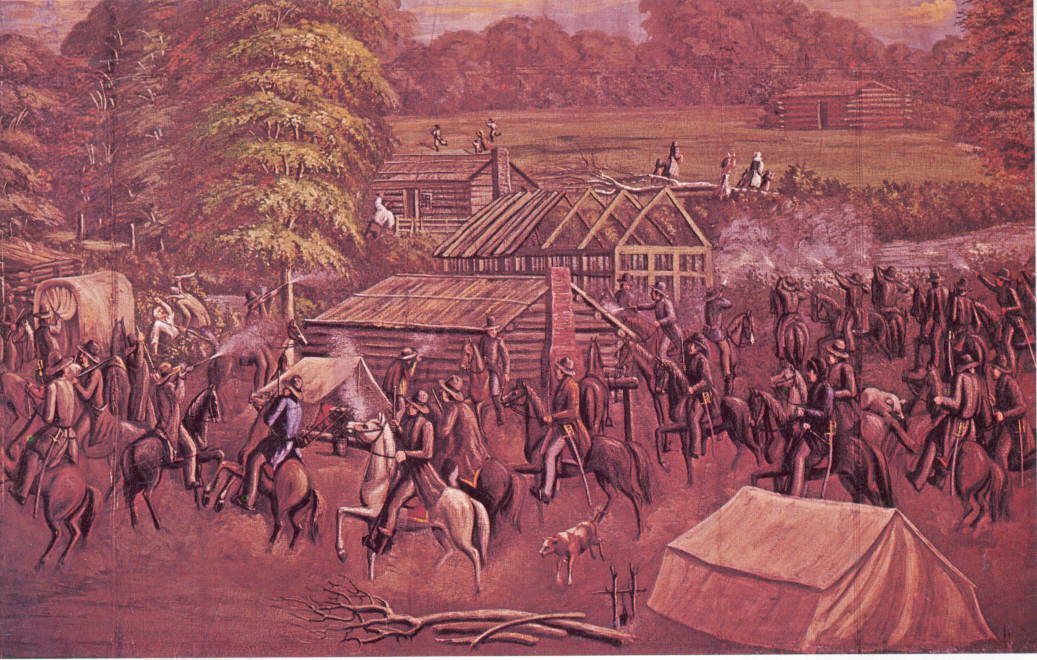
The Haun's Mill Massacre - painting by C.C.A. Christensen. In the left center,
just behind the covered wagon, is a depiction of the murder of Enoch's grandfather,
Thomas White McBride.
Their means of travele was made up of a horse and mare hitched to a wagon, and a yoke of oxen pulling a two-wheeled cart. Seventeen people were dependent on this arrangement. They left Haun's Mill and started for Illinois. The first day they traveled about nine miles and camped in a house, which had been vacated. Since the day had turned extremely cold, they decided to remain there until the weather became more favorable. Early in the morning a few days later they were again on their way. Traveling as far as Pason, Adams County, Illinois, they stopped and rented a farm and raised a crop that year.
They arrived in Nauvoo in April 1840. Enoch spent a good portion of his childhood in Nauvoo where his family was personally acquainted with the Prophet Joseph Smith. The persecutions of the saints became more severe and on Tuesday, June 27, 1844, the Prophet Joseph Smith and his brother Hyrum Smith were murdered at Carthage Jail in Illinois. While living in Nauvoo, Enoch was baptized in 1845 at the age of eight years old.
They were not destined to stay there, for the mob was determined to drive them out of Illinois. Early in the year of 1846, the saints commenced to leave Nauvoo, fleeing the mob, which later drove the remnants out of the city.
In April of 1846, the Dayleys and McBrides left Nauvoo. They stopped at Farmington, Iowa. There they took a job of clearing land at which they worked all summer, being paid a wage of twenty-five cents a day. In September that same year, they left Farmington and moved down the Des Moines River to Tom's Mill, where they stopped and spent the winter.
On about the first of May 1847, they left Tom's Mill and traveled about sixty miles to Centerville, Appanoose County, Iowa. Their teams were not sufficient to take the families and provisions across the plains, so they were forced to spend the winter among unfriendly people in the frontier settlement. The people there were filled with hatred for the Mormons and bitter threats were made toward them. They built cabins to winter in and secured employment. They remained at Centerville until May 17, 1850, then having disposed of their homes and securing better teams and wagons. they again started west.
They reached Kaneseville, Iowa about three hundred miles away where they remained for two years. Kanesville was later known as Bluff City and now known as Council Bluffs. Rather than continuing west to Utah, they remained in Kanesville where Enoch's father, James, served as the bishop.
In the month of June 1852, they again sold their possessions and with supplies for their journey, they faced west once again. At this time, Enoch Rhodes was thirteen years old. He had blue eyes and light brown hair and was a responsible young man.
On June 26, 1852 they set out with the John B. Walker Company which consisted of 258 people. Enoch's duty was to drive an ox team across the plains. They made the long trek with only the usual pioneer trials. At one point there was a cholera outbreak in the company. By this time they had a somewhat better experience than those who first blazed the way. They arrived in Salt Lake City on October 2, 1852. From there they were sent to settle in Grantsville, Tooele County, Utah where his father bought a farm near Harrison Severe, his brother-in-law.
John
William Cooley was another settler in Grantsville, arriving in the
fall of 1853. He and his family moved to a place just a mile or two
away from the Dayley family. In his family was a pretty little
black-eyed daughter, Genette, who was sixteen years old. 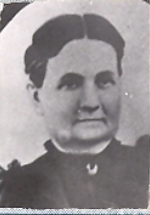
Gennette Cooley Dayley
Enoch and Genette fell in love and were married December 29, 1856. They lived in Grantsville until after the birth of their first child, Enoch Rhodes, Jr., on February 27, 1858. Enoch received his endowments on February 18, 1858 in the Endowment House in Salt Lake. Later that year, Enoch was called by the church leaders to help with the settlement of Richmond, Cache County, Utah. They moved there where they remained until the spring of 1867. While living there, three of their children were born; George Owen (14 Feb 1860), James Keller (10 Jun 1862), and, John William (28 May 1865).
They had some problems with the Indians there. Early in 1867, some Indians stole his oxen and cattle, forcing them to move into the fort for protection. Later that year they moved back to Granstville, where they lived for the next thirteen years. Here four more children were born; Charles Dayley (14 Jul 1867), Gennette Isabelle who went by Nettie (18 Oct 1871), Porteous Donald (10 Jun 1873), and Mary Hannah (13 Oct 1875). Mary Hannah died a few months later on February 9, 1876.
In
the spring of 1878, President Francis M. Lyman, President of the
Tooele Stake, sent Enoch's father, James and four of Enoch's
brothers, Jacob, Heber, Thomas, and Elisha, to look for a valley they
had heard about across the boarder in Idaho. They found the area
called Little Basin, near Oakley, Idaho. The original group plus a
few others returned to Basin in 1879. The first year they raised some
wheat and potatoes and planted gardens. In
the fall of 1879, Enoch came to Basin and located a homestead for his
family. He spent the next year getting it ready to bring his family
from Utah.
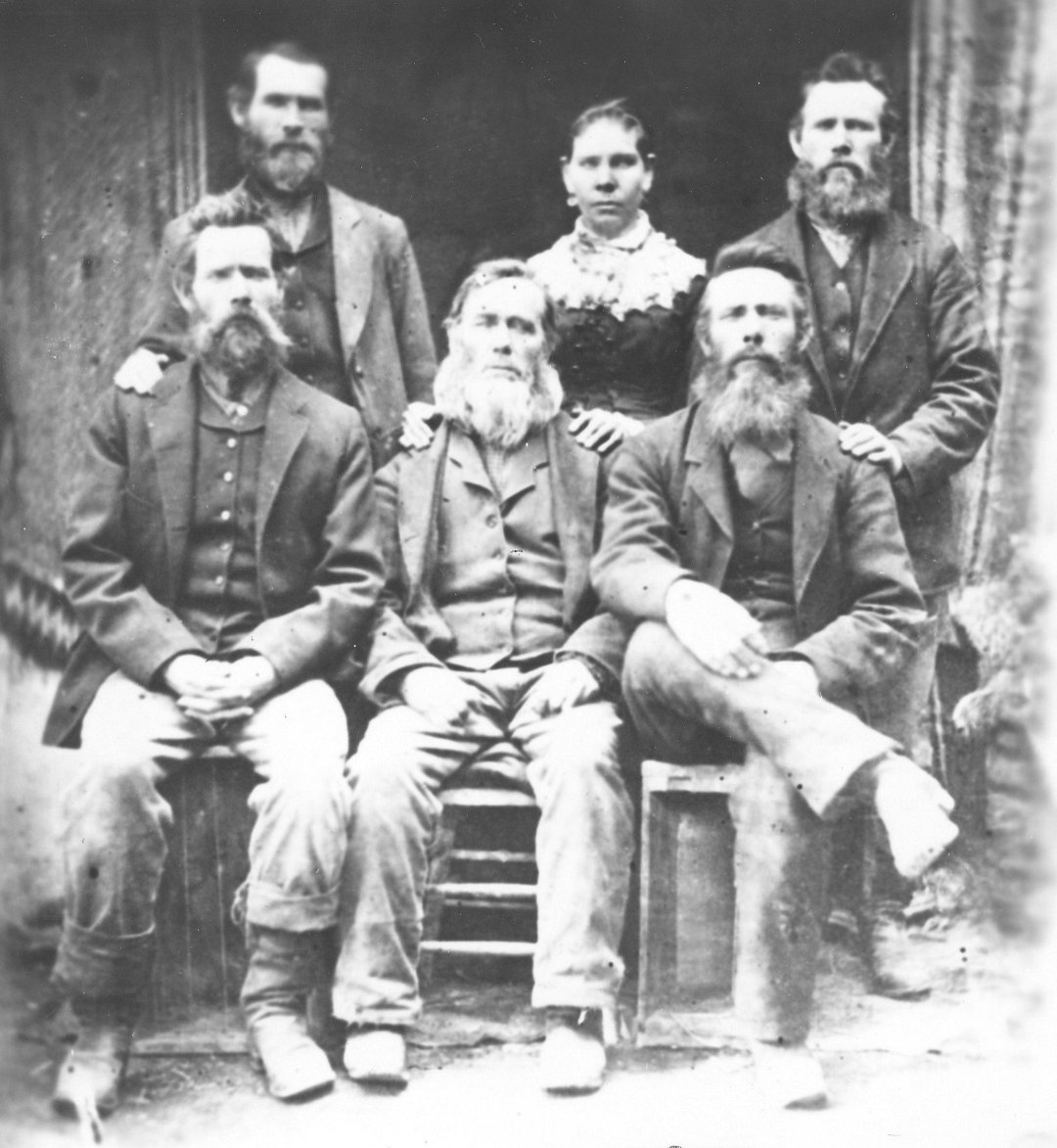
Standing: Jacob Dayley, Isabelle Dayley Phillips, and Thomas Dayley.
Seated: Heber Dayley, James Dayley, Sr., and Enoch Rhodes Dayley.
About the same time Cassia County was created by the Idaho Territorial Legislature on February 20, 1879, by partitioning Owyhee County, with the county seat at. At that time, Cassia County included all of Cassia and Twin Falls Counties.
At a conference held at Centerville, Utah on March 26, 1880, a branch, known as the Goose Creek Branch of the Tooele Stake was organized. William C. Martindale was President, with George Whittle as first counselor and Enoch Rhodes Dayley as second counselor. These three men, along with Francis M. Lyman, president of the Tooele Stake, then came to the Oakley valley for the purpose of purchasing water rights, which were held by certain stockmen, and to prepare for a general colonization.
The organization of the branch was completed May 9, 1880 at the home of Thomas Dayley in Little Spring Basin, five miles east of Oakley. There were fourteen members present at that meeting. The branch included Basin and Oakley. Meetings were held alternately at Basin and Oakley, Elder Dayley presiding at Basin and Elder Martindale presiding at Oakley.
Enoch returned to Grantsville in the fall of 1880 to move his family to Basin. When the family came to the new frontier, they brought seed for planting crops, which included starts of rhubarb, gooseberry bushes, current bushes and cuttings from trees to give them shade in the years ahead. Sugarcane was planted in the vicinity of Marion, Idaho because they thought the climate more favorable for its growth. They also brought yellow roses to make their yards beautiful.
One
year in the early days of Basin, it was discovered early in the
spring that there were great numbers of cricket larva in the ground
ready to hatch, many times more than had ever been noted before. The
people knew that when they did come out of the ground they would eat
up every bit of vegetation in sight, which would mean disaster for
all concerned. They called a day of fasting and prayer, believing
that the Lord would deliver them from the menace. The next day it
rained, softening the ground and the crickets came out by the
millions, the ground crawled with them. That night it froze, killing
all of the crickets. 
The orginal Basin Meetinghouse
In August 1881, a Sunday school was organized in Basin by Enoch and William Moultrie. Then, in 1882 the Goose Creek Branch became the Cassia Ward, which included all of South Central Idaho. At that time and was taken from the Tooele Stake and was made as part of the Box Elder Stake.
At a special conference held in Oakley, Cassia County, Idaho on Saturday November 19, 1887, Cassia Ward was organized as the Cassia Stake of Zion, embracing the saints who had settled in South Central Idaho. On Tuesday, November 22, 1887 at a special meeting held at Spring Basin, the branch of the church previously established there was organized as the Basin Ward with Enoch Rhodes Dayley as the Bishop, a position in which he served the rest of his life. At the same time, wards were also created in Oakley, Marion, Albion, Almo, Elmo, and Carey.
Not only was Cassia County growing, settlements had been established all along the Snake River. Ranching, farming, and mining drew settlers to all regions of the Territory. On July 3, 1890 Idaho was granted statehood.
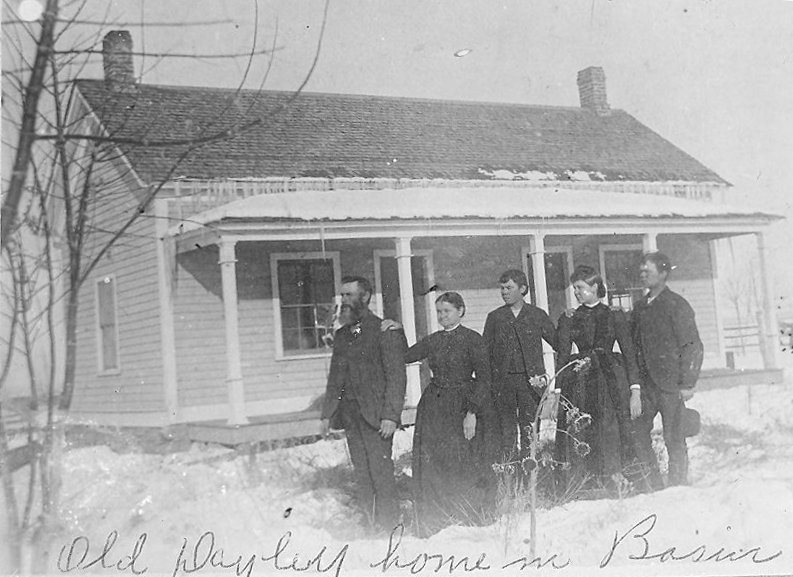
The Dayley home in Basin. Left to right: Enoch, Gennette,
Porteous, Nettie, and Charles.
In
October 1891 the entire family made a trip to Logan, Utah where Enoch
and Gennette were sealed
in the Logan Temple on October 21, 1891. At that time, all of their
children were also sealed to them, including Mary
Hannah, who was sealed by proxy.
In the fall of 1892, Gennette became very ill, neigh unto death, Enoch prayed that her life would be spared and his taken instead. His prayer was answered almost immediately when Gennette was healed, as if by a miracle. A short time later, Enoch died suddenly on November 13, 1892 at the age of 55. He is buried in the Basin Cemetery. Gennette lived another thirty four years and died on February 26, 1927 and is buried next to Enoch.
Enoch Rhodes Dayley was a leader among men. He was a kind gentleman, slow to anger and very patient. He loved people and tried very hard to teach them a better way of life by example. He was the father of eight children, two daughters and six sons. From his fifty eight grandchildren, his legacy is passed on to a large posterity numbering in the thousands.

The monument that marks the final resting place of
Enoch Rhodes Dayley in the Basin Cemetery.

Is ever God with His image blessed.
The friend of man, the friend of truth,
The friend of age, the friend of youth.
* * * * * * * *
The main source of this story is from an account written by Bertha Dayley Spargo, a granddaughter of Enoch Rhodes Dayley, the daughter of Porteious D. Dayley
An
account of the John B. Walker Company of 1852 is found at:
http://lds.org/churchhistory/library/pioneercompany/1,15797,4017-1-309,00.html
Other pieces come from the Life Stories of Gennete Cooley and James Dayley